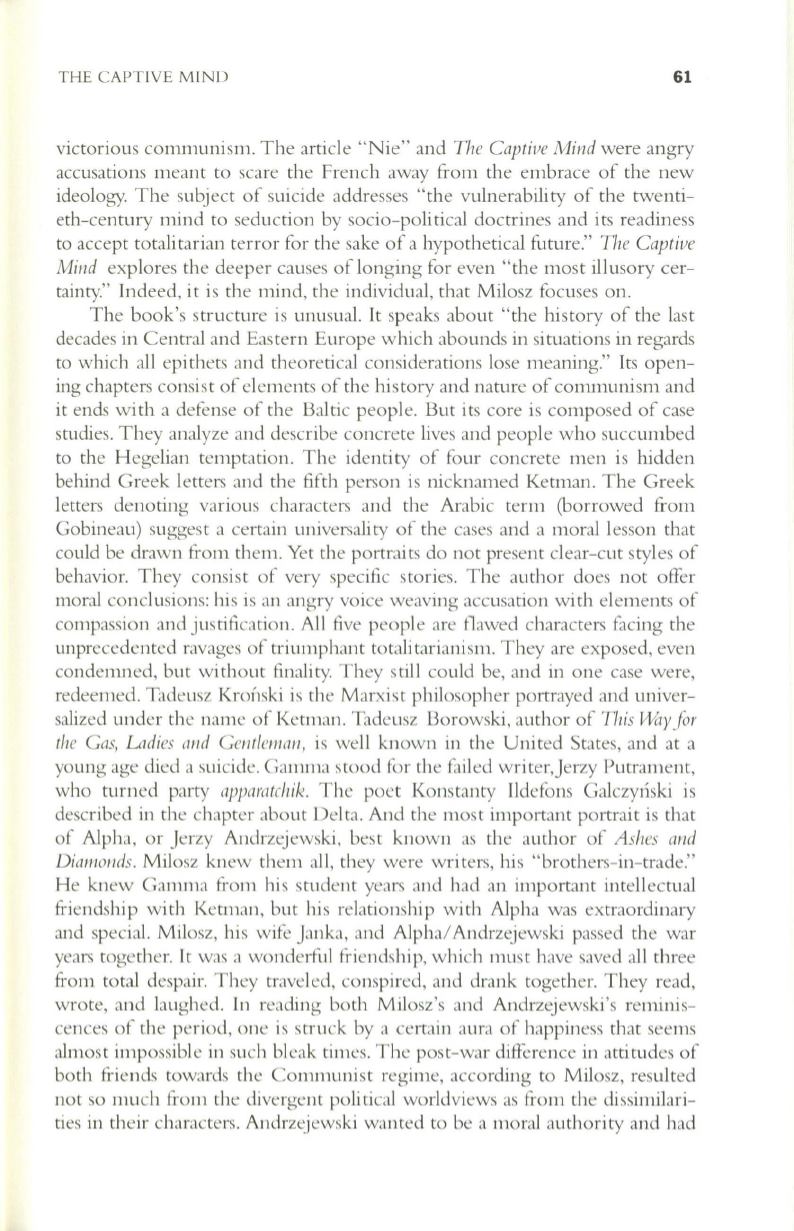
THE CAPTIVE MIND
61
victorious communism. The article "Nie" and
The Captive Mind
were angry
accusations meant to scare the French away from the embrace of the new
ideology. The subject of suicide addresses "the vulnerability of the twenti–
eth-century nund to seduction by socio-political doctrines and its readiness
to accept totali tarian terror for the sake of a hypothetical future."
Tne Captive
Mind
explores the deeper causes oflonging for even "the most illusory cer–
tainty." Indeed, it is the nund, the individual, that Milosz focuses on.
The book's structure is unusual. It speaks about "the history of the last
decades in Central and Eastern Europe which abounds in situations in regards
to which all epi thets and theoretical considerations lose meaning." Its open–
ing chapters consist of elements of the history and nature of communism and
it ends with a defense of the Baltic people. But its core is composed of case
studies. They analyze and describe concrete lives and people who succumbed
to the Hegelian temptation. The identi ty of four concrete men is hidden
behind Greek letters and the fifth person is nicknamed Ketman. The Greek
letters denoting various characters and the Arabic term (borrowed from
Gobineau) suggest a certain universality of the cases and a moral lesson that
could be drawn £i·om them. Yet the portrai ts do not present clear-cut styles of
behavior. They consist of very specific stories. The author does not offer
moral conclusions: his is an angry voice weaving accusation with elements of
compassion and justification. All five people are flawed characters facing the
unprecedented ravages of triumphant totalitarianism. They are exposed, even
condemned, but without finality. They still could be, and in one case were,
redeemed. Tadeusz Krol1ski is the Marxist philosopher portrayed and univer–
salized under the name of Ketman. Tadeusz Borowski, author of
This
Vlily
Jor
the Gas, L1dies alld Gel/tieman,
is weJl known in the Uluted States, and at a
young age died a suicide. Gamma stood for the failed writer,Jerzy Putrament,
who turned party
apparatchik.
The poet Konstanty Ildefons Galczyriski is
described in the chapter about Delta. And the most important portrait is that
of Alpha, or Jerzy Andrzejewski, best known as the author of
Ashes and
Diamonds.
Milosz knew them all, they were writers, his "brothers-in-trade."
He knew Gamma fi·om his student years and had an important intellectual
friendship with Ketman, but his relationship with Alpha was extraordinary
and special. Milosz, his wife Janka, and Alpha/Andrzejewski passed the war
years together. It was a wonderful friendship, which must have saved all three
from total despair. They traveled, conspired, and drank together. They read,
wrote, and laughed. In reading both Milosz's and Andrzejewski's renunis–
cences of the period, one is struck by a certain aura of happiness that seems
almost impossible in such bleak times. The post-war difference in attitudes of
both friends towards the CommUIust regime, according to Milosz, resulted
not so much from the divergent political worldviews as from the dissirnilari–
ties in their characters. Andrzejewski wanted to be a moral authority and had


